Science news highlights of 2010
- Published
2010 was a year dominated by the repercussions of the Deepwater Horizon accident, which caused the biggest ever release of oil into the ocean.
In the world of research, we were introduced to "Synthia", the first life form with synthetic DNA, and "X-woman", a new member of the human family tree.
BBC science reporter Paul Rincon looks back at the twists and turns of a year in science and the environment.
JANUARY
"I am not going to stand down, I am going to stand up."
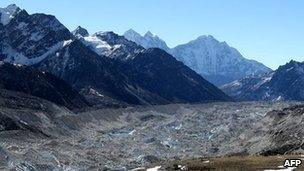
The IPCC report said Himalayan glaciers could vanish by 2035
Those were the words of Rajendra Pachauri, head of the UN's climate science body, who remained bullish, external amid calls for his resignation over a mistake, external in the panel's 2007 assessment of climate impacts.
After criticism from - among others - the Indian government, external, the Intergovernmental Panel on Climate Change (IPCC) admitted it was in error, external by asserting that Himalayan glaciers could disappear by 2035.
In January, researchers announced an ingenious new technique for working out the colours of plumage preserved on dinosaur fossils, external.
The team revealed that a "mohican" of bristles on a 125-million-year-old dinosaur was, in fact, ginger-coloured feathers.
FEBRUARY
In 2010, the Sun was awakening following a quiet period. An opportune time, then, for the US space agency (Nasa) to launch its Solar Dynamics Observatory (SDO), external from Cape Canaveral in Florida.
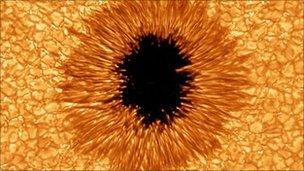
A ground-based telescope took this image of a sunspot
During active periods, the Sun sends bursts of high energy particles hurtling in our direction.
These can wreak havoc with communications on Earth, including the sat-nav signals we increasingly rely on, external. SDO is designed to explain variations in solar activity.
Another Nasa probe is steadily approaching icy Pluto, millions of kilometres from the Sun. Pluto undergoes dramatic seasonal changes, external, astronomers using the Hubble Space Telescope declared in February.
MARCH
Researchers succeeded in creating a "quantum state", external in the largest object yet - a metal paddle just big enough to be seen by the naked eye.
Such states, in which an object is effectively in two places at once, have until now only been accomplished with single particles - atoms and molecules.
Back in the classical world, geneticists uncovered evidence for a previously unknown type of human, external that lived roughly 50,000 years ago, which they nicknamed "X-woman".
The finding comes from analysis of DNA in a finger bone unearthed at Denisova Cave, external in Siberia. Other finds and even more astonishing revelations about the "Denisovans" were to come in December.
APRIL
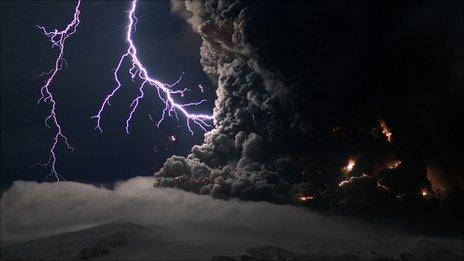
The eruption of Eyjafjallajokull grounded flights across European airspace
Before this year, few people outside Iceland had heard of Eyjafjallajokull. Most of those who had probably couldn't pronounce it.
But the volcano's explosive outpourings in 2010, external resulted in the largest air traffic shutdown, external since World War II.
Geologists were, understandably, at a loss to predict how long the eruptions would last, external. And there was no agreement over the safety of flying through the ash cloud, external.
Eyjafjallajokull quietened down in the second half of 2010, but there are many other outlets, external for the searing magma that courses beneath Iceland's active surface.
An explosion aboard the Gulf of Mexico oil rig, external Deepwater Horizon left 11 workers dead. As the oil flowed unchecked into Gulf waters, the fragile relationship between human activities and the immense forces of nature was again brought into sharp focus.
MAY
The announcement that researchers had developed world's first living cell controlled by synthetic DNA should have come as no surprise to those who have followed the career of one J Craig Venter.

The organism nicknamed "Synthia" is controlled by what the group calls "genetic software"
Dr Venter publicly revealed his intention to create artificial microbes as far back as 1999, external. Rumours of the breakthrough had been circulating for months before details were published in Science journal.
The Maryland-based team transplanted "genetic software" into a host cell. The resulting microbe then looked and behaved like the species "dictated" by the synthetic DNA.
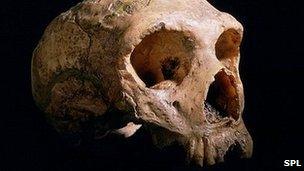
In, then out, then in again: we can now call the Neanderthals "ancestors"
Venter wants to use such cells to produce medicines, fuels and even absorb greenhouse gases. Others claim the potential benefits of the technology have been overstated.
The other big story of the month also came from the field of genetics. Scientists unveiled a draft sequence of the Neanderthal genome, external.
Analysis of the nuclear DNA, external from our evolutionary relatives revealed that modern humans and Neanderthals probably interbred, external; after thousands of years Neanderthal genes can be detected in living people, external.
JUNE
The US Geological Survey estimated that as many as 40,000 barrels of oil per day were flowing into the Gulf of Mexico from the Deepwater Horizon well before BP capped it on 3 June.
Meanwhile, US President Obama told the media he had been consulting with experts so he could learn "whose ass to kick" in the matter. Later the same month, BP boss Tony Hayward received a severe grilling before the US Congress, which accused him of "stonewalling".
Results from an experiment at the US Tevatron particle smasher offered a clue as to why the world around us is composed of normal matter and not its shadowy opposite: anti-matter.
They found that particle collisions produced pairs of matter particles slightly more often than they yielded anti-matter particles.
JULY
The last of three UK reviews into the ClimateGate affair exonerated climate scientists of any dishonesty, but criticised a lack of openness. But the reviews did not satisfy "sceptical" bloggers, who called for their own investigation.
The evolving role of the blogosphere in science came to the fore as particle physicists were preparing to gather in Paris for their annual conference. Internet rumours suggested that the US Tevatron particle smasher had seen hints of the elusive Higgs boson, external.
The rumours were quickly scotched, but scientists later announced they had narrowed the range of masses where the Higgs could hide by about one quarter.
From the very tiny to the very large: In July, astronomers announced the discovery of the biggest known star in the Universe. Even so, it is too small to register in the first full-sky image from the Planck telescope.
AUGUST
The scale of the Deepwater Horizon spill was vividly brought home by the real-time video of oil gushing violently from the torn Macondo Well.

Oil escaping from the Macondo well remains one of the most vivid images of 2010
But in August, the US government confirmed that the spill was the biggest ever accidential release of oil into the oceans, exceeding the 1979 Ixtoc I leak.
It will take much longer to acertain the impact of the accident on ecology in the Gulf of Mexico.
An independent review, external commissioned to look into errors in the UN climate body's 2007 report concluded that the Intergovernmental Panel on Climate Change needed stricter checks to prevent damage to the organisation's credibility.
SEPTEMBER

An artist's impression of the Earth-like planet and its parent star
The race to discover habitable worlds around distant stars warmed up in September, as an international group discovered an Earth-like planet in the so-called "Goldilocks Zone".
This is the region around a star where it is neither too hot nor too cold for life. Co-author Steven Vogt says that any indigenous life "would have a wide range of stable climates to choose from and to evolve around".
Closer to home, Thad Allen, the US coastguard official overseeing the Gulf oil spill clean-up, announced that the ruptured well was finally sealed and "effectively dead", posing no further risk to the environment.
OCTOBER
October kicked off with the Nobel Prizes. This year's prize for physics was awarded to the UK-based, Russian-born scientists Andre Geim and Konstantin Novoselov for their "groundbreaking" work on graphene, a form of carbon with amazing properties. Amazingly, it all started with a sticky tape trick.

Andre Geim shared the Nobel prize for the development of graphene
Scientists working for the UN said they had eradicated, external one of the most lethal cattle diseases known to science.
The rinderpest virus became only the second viral disease - after smallpox - to be eliminated by humans.
The UN biodiversity conference in Nagoya, Japan, agreed a 10-year plan aimed at preserving nature. However, some of the targets were weaker than conservation scientists had hoped for.
NOVEMBER
When the UK coalition government's spending review was finally announced in November, science was spared deep cuts. Chancellor George Osborne announced that the the UK's science budget would be frozen in cash terms - a cut of less than 10% over four years.
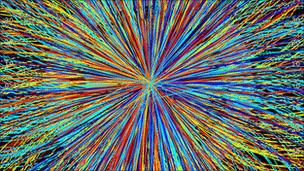
One of the lead-ion collisions at the LHC, as seen by the ALICE experiment
But concerns remained that the outcome could damage the country's economic competitiveness and lead to a brain drain. And worse news was to come the following month.
The UK is one of many countries with membership of Cern, external (the European Organization for Nuclear Research). In November, Cern's Large Hadron Collider successfully created a "mini-Big Bang" by smashing together lead ions.
The experiment generated temperatures a million times hotter than at the centre of the Sun in a bid to recreate the conditions in the Universe a millionth of a second after the Big Bang. Meanwhile, another experiment at Cern, Alpha, reported trapping atoms of antimatter for the first time.
DECEMBER
UK science funding bodies learned they would have to absorb cuts of 41% to their capital expenditure - money spent on building, maintainance or equipment. These are on top of the 10% real terms cut announced in November.

Under the Cancun deal some countries escape the extension of emission cuts under the Kyoto Protocol
Researchers discovered a bacterium that uses arsenic in the place of phosphorus - one of six elements previously thought indispensable for all life forms. Some in the blogosphere had anticipated a possible announcement of evidence for alien life, external. This was wide of the mark, but chemistry using arsenic may be easier on freezing worlds like Saturn's moon Titan.
The UN's climate conference in Cancun, external, Mexico, started amid low expectations after the failure of the 2009's Copenhagen summit. But almost all nations at the meeting endorsed texts drawn up by the Mexican hosts, putting climate negotiations back on track.
As the year closed, scientists said the ancient humans dubbed "Denisovans" had mixed and interbred with our own species. Together with the results of the Neanderthal genome project, the findings are forcing yet another significant revision to our knowledge of human origins.